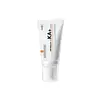What's inside
What's inside
 Key Ingredients
Key Ingredients

 Benefits
Benefits

No benefits
 Concerns
Concerns

 Ingredients Side-by-side
Ingredients Side-by-side

Water
Skin ConditioningC12-15 Alkyl Benzoate
AntimicrobialGlycerin
HumectantEthylhexyl Salicylate
UV AbsorberTitanium Dioxide
Cosmetic ColorantBis-Ethylhexyloxyphenol Methoxyphenyl Triazine
Skin ConditioningButyl Methoxydibenzoylmethane
UV AbsorberAlcohol Denat.
AntimicrobialEthylhexyl Triazone
UV AbsorberDimethicone
EmollientOctocrylene
UV AbsorberNiacinamide
SmoothingPanthenol
Skin ConditioningPentylene Glycol
Skin ConditioningStearic Acid
CleansingPotassium Cetyl Phosphate
EmulsifyingMethyl Methacrylate Crosspolymer
Nylon-12
Propylene Glycol
HumectantSynthetic Wax
AbrasiveAluminum Hydroxide
EmollientAmmonium Polyacryloyldimethyl Taurate
Emulsion StabilisingCaprylyl Glycol
EmollientDisodium EDTA
Drometrizole Trisiloxane
UV AbsorberGlyceryl Stearate
EmollientGlycine Soja Oil
EmollientHydroxypropyl Methylcellulose
Emulsion StabilisingIsopropyl Lauroyl Sarcosinate
Skin ConditioningMyristic Acid
CleansingPalmitic Acid
EmollientPEG-100 Stearate
Phenoxyethanol
PreservativeSodium Chloride
MaskingStearyl Alcohol
EmollientTerephthalylidene Dicamphor Sulfonic Acid
UV AbsorberTocopherol
AntioxidantTriethanolamine
BufferingWater, C12-15 Alkyl Benzoate, Glycerin, Ethylhexyl Salicylate, Titanium Dioxide, Bis-Ethylhexyloxyphenol Methoxyphenyl Triazine, Butyl Methoxydibenzoylmethane, Alcohol Denat., Ethylhexyl Triazone, Dimethicone, Octocrylene, Niacinamide, Panthenol, Pentylene Glycol, Stearic Acid, Potassium Cetyl Phosphate, Methyl Methacrylate Crosspolymer, Nylon-12, Propylene Glycol, Synthetic Wax, Aluminum Hydroxide, Ammonium Polyacryloyldimethyl Taurate, Caprylyl Glycol, Disodium EDTA, Drometrizole Trisiloxane, Glyceryl Stearate, Glycine Soja Oil, Hydroxypropyl Methylcellulose, Isopropyl Lauroyl Sarcosinate, Myristic Acid, Palmitic Acid, PEG-100 Stearate, Phenoxyethanol, Sodium Chloride, Stearyl Alcohol, Terephthalylidene Dicamphor Sulfonic Acid, Tocopherol, Triethanolamine
 Reviews
Reviews

Ingredients Explained
These ingredients are found in both products.
Ingredients higher up in an ingredient list are typically present in a larger amount.
You might know this ingredient as Tinosorb S or Bemotrizinol. It is a UV filter that covers both UVA and UVB rays.
This ingredient has two peak UV absorption peaks ( 310 and 340 nm) and is able to absorb both UV-A and UV-B rays. This ingredient works by preventing UV rays from reaching and damaging your skin.
On top of that - it is highly photostable and helps prevent the photodegration of other sunscreen ingredients such as avobenzone.
Tinosorb S is allowed in the EU, Australia, and Asia. It is close to being approved by the FDA and we'll hopefully get this ingredient in the U.S. by late 2025.
Fun fact: Tinosorb S is the most effective UV absorber at maximum concentration (measured by SPF) permitted in the EU.
This ingredient is oil-soluble, so your oil-cleansers will take this right off at night.
Learn more about Bis-Ethylhexyloxyphenol Methoxyphenyl TriazineAlso known as Avobenzone, this ingredient is a chemical sunscreen filter that provides protection in the UV-A range.
Avobenzone is globally approved and is the most commonly used UV-A filter in the world.
Studies have found that avobenzone becomes ineffective when exposed to UV light (it is not photostable; meaning that it breaks down in sunlight). Because of this, formulations that include avobenzone will usually contain stabilizers such as octocrylene.
However, some modern formulations (looking at you, EU!) are able to stabilize avobenzone by coating the molecules.
Avobenzone does not protect against the UV-B range, so it's important to check that the sunscreen you're using contains other UV filters that do!
The highest concentration of avobenzone permitted is 3% in the US, and 5% in the EU.
Learn more about Butyl MethoxydibenzoylmethaneEthylhexyl Triazone is a modern chemical sunscreen that protects from UV-B radiation.
It is the most effective of existing UV-B filters, as it provides the highest level of photo-stable absorption. It protects from the entire UV-B range (280 to 320nm), with it's highest level of protection at 314nm.
Ethylhexyl Triazone is oil soluble, oderless and colorless, which mean it is able to be incorporated into a variety of different formulations.
It is not currently available within the United States due to slow changing FDA regulations. Outside of the US, it is used in formulations at concentrations up to 5%.
Learn more about Ethylhexyl Triazone